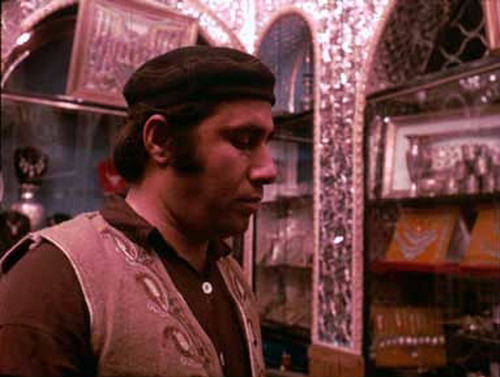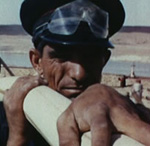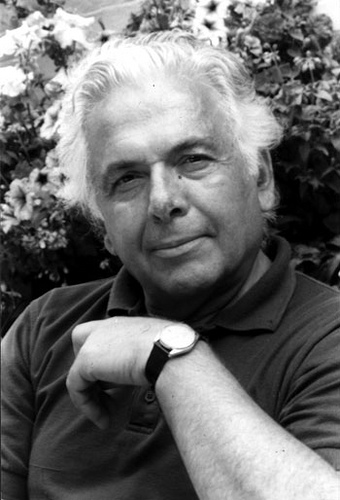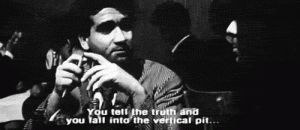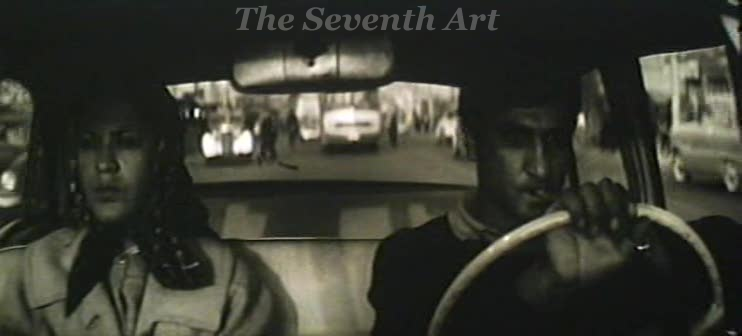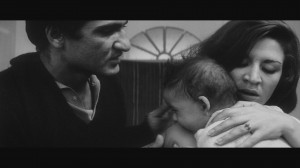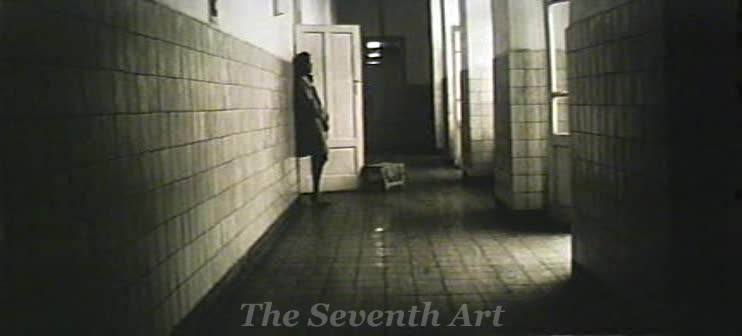Here is an essay about Ebahim Golestan that appeared in the Chicago Reader on May 3, 2007, along with capsule reviews of three Golestan programs that showed in Chicago the same week. I posted these shortly after reseeing the remarkable and criminally neglected Brick and Mirror at the Edinburgh International Film Festival, with Golestan, now in his early 90s, both present and eloquent in speaking about his work. Note: if you hit the subtitled still below, you can see a very brief silent clip from Brick and Mirror. — J.R.
Brick and Mirror
A high point of Iran’s first new wave, this 1964 masterpiece by Ebrahim Golestan takes its title from the classical Persian poet Attaar, who wrote, “What the old can see in a mud brick, youth can see in a mirror.” The philosophical implications of this are fully apparent in Golestan’s tale of a young man who finds a baby girl in his cab and spends a night with his girlfriend debating what to do with the infant. Though this black-and-white ‘Scope film superficially resembles Italian neorealism, especially in its indelible look at Tehran street life and nightlife in the 60s, its spirit is a mix of Dostoyevsky and expressionism: minor characters periodically step forward to deliver anguished soliloquies, contributing to an overall lament both physical and metaphysical. In Farsi with subtitles. 124 min.
The Secret of the Treasure of the Jinn Valley
Having moved to London in 1967, the distinguished Iranian writer, translator, producer, and director Ebrahim Golestan returned to his homeland to make this unpleasant allegorical comedy (1972), his second and final feature to date. A bitter satire about the shah’s corrupt regime, it centers on a poor peasant who plunges into a hidden cave, discovers a cache of valuable antiques, and becomes a grotesque nouveau riche tyrant. Golestan tackled a related theme in his exquisite 1965 short The Iranian Crown Jewels, which was commissioned and then banned by the shah’s cultural ministry, but that film attacked the very elitism that subsumes this one. The print being shown is badly faded, but the period ambience is still vivid. In Farsi with subtitles. 118 min. (JR)
Documentaries by Ebrahim Golestan
This remarkable program collects four pioneering shorts by Iranian writer and filmmaker Ebrahim Golestan, who began producing industrial films for the oil companies in the 50s and evolved into an ambitious and accomplished artist; in some ways his documentaries are comparable to the early work of Alain Resnais. The Wave, Coral and Rock (1961, 40 min.), the most conventional, chronicles the building of a jetty and the laying of pipelines, while A Fire (1961, 25 min.), edited by the great poet Forough Farrokhzad, chronicles a protracted oil fire. The Hills of Marlik (1963, 15 min.) beautifully and suggestively documents archaeological excavations, and The Iranian Crown Jewels (1965, 15 min.), commissioned and then banned by the shah’s cultural ministry, is a formally dazzling and politically provocative brief on its subject. The first three are in English and subtitled Farsi; the last is unsubtitled, but copies of the English text will be provided. (JR)
Before the Revolution
Ebrahim Golestan: Lion of Iranian Cinema
Imagine how different our understanding of film history would be if we were denied access to everything made before the so-called sound revolution. A much more profound revolution interferes with our grasp of the history of Iranian film. During the fundamentalist revolution of 1979, the Islamic clergy said cinema was a form of Western exploitation as corrupt as prostitution and over 100 movie theaters were burned to the ground.
Much of what we know today as the Iranian New Wave — the films of Abbas Kiarostami, Mohsen Makhmalbaf, and Jafar Panahi — reflects some of that anxious background. But there were actually two new waves: most of the major figures from the first were driven into exile, their films rendered practically invisible in the process.
Both new waves are associated with Italian neorealism and the ethics of humanism, but there are pronounced differences. The second has notably developed in relative independence from commercial filmmaking practices in the West. But the first, associated with Ebrahim Golestan, Parviz Kimiavi, and Sohrab Shahid Saless, was contemporary with the French New Wave, and reflects the modernity of that period. Bahram Beizai, Dariush Mehrjui, and Amir Naderi are among the few filmmakers who might be stylistically associated with both waves, but given how seldom their prerevolution films are seen nowadays (apart from Mehrjui’s The Cow) it’s difficult to say much about them.
I saw my first Iranian film, Kimiavi’s The Mongols (1973), a biting Godardian satire about the stereotypical way Iranians are viewed in the West, in London in the mid-70s and haven’t seen it turn up anywhere since. If it’s ever been shown in the U.S., its impact has been slight. The same could be said for Golestan’s no less modern Brick and Mirror (1964) and Saless’s equally innovative A Simple Event (1973). When Golestan immigrated to England, Kimiavi to France, and Saless to Germany, their films were left behind or displaced, and are now absent from our sense of film history. But an excellent subtitled 35-millimeter print of Brick and Mirror, along with five other films by Golestan (four of them shorts), wound up in a local archive, and this week the Gene Siskel Film Center is showing them, with the director in attendance.
An important literary figure in Iran, Golestan is celebrated both for his short stories and for his Persian translations of American literature, including Huckleberry Finn and works by Stephen Crane, William Faulkner, Ernest Hemingway, and Eugene O’Neill. In 1956 he set up his own film-production business to make “industrials” for oil companies and gradually branched out, releasing increasingly ambitious films through the mid-60s (including Forough Farrokhzad’s The House Is Black, for me the greatest of all Iranian films, and the only one from the first wave available on DVD). Judging from the five shorts I’ve seen from this period, his remarkable development is comparable in some ways to Alain Resnais in France during the previous decade.
Resnais’ shorts were commissioned documentaries, but while taking on such topics as African sculpture and colonialism, the Nazi death camps, the French national library, and plastic manufacturing, he was able to incorporate creative camera movements and edits as part of his formal structures as well as poetic meditation, literary narration, and at times controversial political positions. Similarly, Golestan appears to have approached his films on a protracted oil fire (1961’s A Fire) and archaeological excavations (1963’s The Hills of Marlik) as highly productive workshops. The Iranian Crown Jewels, a 1965 film commissioned and then banned by the shah’s cultural ministry, features dazzling edits and camera movements and a charged narration assaulting economic disparities. (This is the only Golestan film in the series lacking English subtitles, but a translation of the text will be handed out at the screenings.)
Golestan has made only two features, Brick and Mirror and The Secret of the Treasure of the Jinn Valley (1972). Only seven years separate them, but they hardly seem the work of the same man. Jinn Valley, a satirical, allegorical farce about a peasant corrupted by wealth, is interesting for its brassy visual style and what it says about Golestan’s escalating rage toward the shah’s regime, but it’s also bitter, misanthropic, and elitist.
Brick and Mirror, by contrast, is a masterpiece, perfectly focused in its withering portrayal of hypocritical intellectuals preaching altruism. Its tragic narrative, taking place over 24 hours and moving from a rapid first half to a slow second, shows us a Tehran radically different from anything we’ve seen in the second Iranian New Wave — especially in an early nightclub scene featuring a woman dancing onstage, at least one gay audience member, and a lot of bohemian atmosphere.
What’s deceptive about the film is that it combines a neorealistic look (in black and white and ‘Scope) with visual and dramatic modes that suggest expressionism and metaphysics. Peripheral characters periodically take over the story, and some of their monologues suggest Dostoyevsky in recounting the world’s misery. (The title derives from a somewhat cryptic line by the 13th-century Persian poet Sa’adi that says what the old can see in a mud brick, youth can see in a mirror.)
The film opens at night with a cabdriver named Hashemi (Zackaria Hashemi) listening to a man on the radio read a story set in a nocturnal forest. (The voice is Golestan, recognizable from his prosaic portion of the narration in The House Is Black.) Hashemi picks up a woman (Farrokhzad, seen only obliquely in a cameo) who directs him to a dirt road on a hillside. After dropping her off, he discovers she’s left a baby girl in the backseat. Clutching the baby, he runs after the woman and suddenly finds himself at the head of a steep stairway descending into darkness. Three rapid jump cuts moving down the steps and away from him emphasize his paralysis and isolation. He eventually winds up at a huge construction site, no less theatrically lit, speaking to a homeless woman in a scene that in its ambience briefly recalls Orson Welles’s The Trial.
We move next to a noisy nightclub where Hashemi, baby in tow, explains his dilemma to a group of flippant, dandyish friends and acquaintances as well as to his girlfriend, Taji (Taji Ahmadi). Later, at a police station, he’s advised to take the baby to an orphanage if no one claims her by morning. Taji meets Hashemi there and insists on returning with him to his one-room flat, where they spend an uneasy night: he’s paranoid that the neighbors will jump to conclusions about his sex life, she’s anxiously hopeful that they’ll keep the baby and get married.
The film’s emotional climax occurs the next morning, with Taji alone in the orphanage. It’s an extraordinary sequence, alternating documentary footage of orphans looking at the camera with Taji’s playful and compassionate responses to them, and culminating with a powerful tracking shot that moves down an endless corridor away from her. Formally it’s a precise complement to the earlier jump cuts, as slow and meditative as those were rapid and breathless, each locating a protagonist in a wider world that’s metaphysical as well as physical, standing on the brink of inconsolable grief.


